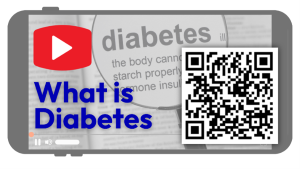Diabetes Week 2025 is coming up, 9th – 15th June and this is a great opportunity to share some resources to help you understand more about Diabates, resources to help if you are living with diabetes, or ways to help prevent getting type 2 diabetes (the most common).
Diabetes is a chronic condition that affects how the body regulates blood sugar levels. Early detection and management of diabetes are crucial to prevent complications and improve overall health.
Watch this great short video from Diabetes UK, to find out more about What is Diabetes – WATCH HERE or scan the QR code
Diabetes in the UK
In 2025 diabetes remains a significant and growing public health concern in the UK. Here’s why:
- Total cases: Over 8 million people in the UK are living with diabetes—a record high.
- Undiagnosed cases: An estimated 3 million people are living with undiagnosed type 2 diabetes.
- At-risk population: Around 3 million people are at increased risk of developing type 2 diabetes (pre-diabetes).
- Combined impact: In total, about 1 million UK adults—roughly 1 in 5—are living with diabetes or pre-diabetes.
- The number of people diagnosed with type 2 diabetes has nearly doubled over the past 15 years and accounts for approximately 90% of all diabetes cases.
- Diagnoses among individuals under 40 are increasing at a faster rate than in older age groups.
- Type 1 diabetes represents about 8% of cases. The remaining 2% includes rarer forms of diabetes.
Causes of diabetes
The amount of sugar in the blood is controlled by a hormone called insulin, which is produced by the pancreas (a gland behind the stomach). When food is digested and enters your bloodstream, insulin moves glucose out of the blood and into cells, where it’s broken down to produce energy. However, if you have diabetes, your body is unable to break down glucose into energy. This is because there’s either not enough insulin to move the glucose, or the insulin produced does not work properly. There are no lifestyle changes you can make to lower your risk of type 1 diabetes, however, you can reduce the risk of type 2 diabetes through healthy eating, regular exercise and achieving a healthy body weight.
Signs and Symptoms
Type 1 and type 2 diabetes share some common symptoms. They can vary in intensity and may not always be noticeable. However, some of the most common signs include:
- Toilet – going for a wee a lot, especially at night.
- Thirsty – being really thirsty.
- Tired – feeling more tired than usual.
- Thinner – losing weight without trying to.
- Genital itching or thrush.
- Cuts and wounds take longer to heal.
- Blurred eyesight.
- Increased hunger.
Find out more about symptoms at Diabetes.org.uk HERE or on the NHS website HERE.
But where type 1 and type 2 diabetes are different in symptom is how they appear. Type 1 can often appear quickly. Type 2 diabetes can be easier to miss because the symptoms are not so obvious. This is because it develops more slowly, especially in the early stages. This is why it is important to know your risk of developing type 2 diabetes. Some people have diabetes and don’t know it. They can have it for up to 10 years without knowing.
Finding out your risk of type 2 diabetes only takes a few minutes. It could be the most important thing you do today…click HERE to start the Diabetes UK ‘know your risk’ online tool.
Find out more about the differences between Type 1 and Type 2 Diabetes HERE.
Diabetes myths and FAQs
Knowing the facts about diabetes is important when it comes to managing the condition. There is so much information out there, but it is not all true. It is often difficult to know what is right and what is not. Head over to the Diabetes UK website to learn more about the myths associated with diabetes. Click HERE to find out more.
Next time…
In our next article we will be sharing resources on effective ways to reduce your risk of Type 2 Diabetes, and advice on how to reverse type 2, known as remission.
